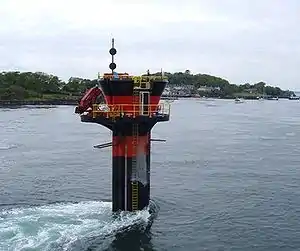SeaGen
SeaGen was the world's first large scale commercial tidal stream generator.[1][2][3] It was four times more powerful than any other tidal stream generator in the world at the time of installation.[4] It was successfully decommissioned by SIMEC Atlantis Energy Limited in summer 2019, having exported 11.6GWh to the grid since 2008.[5]
| SeaGen | |
|---|---|
 Commercial tidal stream generator — SeaGen — in Strangford Lough. The strong wake shows the power in the tidal current. | |

Location of SeaGen in Northern Ireland | |
| Country | Northern Ireland, United Kingdom |
| Location | Strangford Narrows between Strangford and Portaferry |
| Coordinates | 54°22′7.2″N 5°32′45.8″W |
| Status | Decommissioned |
| Commission date | April 2008 |
| Decommission date | July 25 2019 |
| Owner(s) | SIMEC Atlantis Energy Limited |
| Operator(s) | Jeremy Rogers Ryan biggs |
| Employees | Cuan marine services |
| Power generation | |
| Units decommissioned | 2 x 0.6MW |
| Nameplate capacity | 1.2 MW |
| External links | |
| Commons | Related media on Commons |
The first SeaGen generator was installed in Strangford Narrows between Strangford and Portaferry in Northern Ireland. Strangford Lough was also the site of the first known tide mill in the world, the Nendrum Monastery mill where remains dating from 787 have been excavated.
History


Marine Current Turbines, the developer of SeaGen, demonstrated first prototype of tidal stream generator in 1994 with a 15 kilowatt system in Loch Linnhe, off the west coast of Scotland. In May 2003, the prototype for SeaGen, 'SeaFlow', was installed off the coast of Lynmouth, North Devon, England.[6] Seaflow was a single rotor turbine which generated 300 kW but was not connected to the grid. SeaFlow was the world's first offshore tidal generator, and remained the world's largest until SeaGen was installed.[7]
The first SeaGen generator was installed in Strangford Narrows between Strangford and Portaferry in Northern Ireland, in April 2008 and was connected to the grid in July 2008.[8] It generated 1.2 MW for between 18 and 20 hours a day while the tides are forced in and out of Strangford Lough through the Narrows.[6]
During the commissioning of the system a software error caused the blades of one of the turbines to be damaged. This left the turbine operating at half power until autumn 2008.[9] Full power operation was finally achieved on 18 December 2008.[10]
The system was removed in stages between 2016 and 2019,[11][5] after Siemens sold the company and technology to rival Atlantis Resources (now SIMEC Atlantis Energy) in 2015.[12]
Technology
SeaGen generator weighed 300 t (300 long tons).[3][13] each driving a generator through a gearbox like a hydro-electric or wind turbine. These turbines have a patented feature by which the rotor blades can be pitched through 180 degrees allowing them to operate in both flow directions – on ebb and flood tides. The company claims a capacity factor of 0.59 (average of the last 2000 hours). The power units of each system are mounted on arm-like extensions either side of a tubular steel monopile some 3 metres (9.8 ft) in diameter and the arms with the power units can be raised above the surface for safe and easy maintenance access.[1] The SeaGen was built at Belfast's Harland and Wolff's shipyards.[14]
Environmental impact

SeaGen has been licensed to operate over a period of 5 years, during which there will be a comprehensive environmental monitoring programme to determine the precise impact on the marine environment.[15]
References
- Douglas, C.A.; Harrison, G.P.; Chick, J.P. (2008). "Life cycle assessment of the Seagen marine current turbine" (PDF). Proceedings of the Institution of Mechanical Engineers, Part M: Journal of Engineering for the Maritime Environment. Professional Engineering Publishing. 222 (1): 1–12. doi:10.1243/14750902JEME94. S2CID 111126521. Retrieved 10 July 2008.
- "The rise of British sea power". The Independent. 23 March 2008. Retrieved 30 July 2008.
- Julian Rush (31 March 2008). "Power generation: the new wave". Channel 4. Retrieved 30 July 2008.
- Arthur Strain (8 February 2008). "Sea change for energy generation". BBC. Retrieved 10 July 2008.
- "Atlantis Successfully Decommissions 1.2 MW SeaGen Tidal System in Industry First". SIMEC Atlantis Energy. 26 July 2019. Retrieved 3 September 2019.
- Brittany Sauser (29 July 2008). "Tidal Power Comes to Market. A large-scale tidal-power unit has started up in Northern Ireland". Technology Review Inc., Massachusetts Institute of Technology. Retrieved 30 July 2008.
- "Case Studies for Schools: Tidal Power". Department for Business, Enterprise and Regulatory Reform. Retrieved 10 July 2008.
- First connection to the grid
- "Delay in commissioning one of SeaGen's rotors". Marine Current Turbines. 22 July 2008. Retrieved 30 July 2008.
- "Tidal energy system on full power". BBC. 18 December 2008. Retrieved 25 June 2009.
- "Strangford tidal energy turbine to be removed". BBC. 27 January 2016. Retrieved 25 June 2017.
- "Atlantis strikes deal to acquire marine energy tech company from Siemens". Hydro Review. 1 May 2015. Retrieved 5 February 2018.
- "World's first as £12m turbine installed in Strangford Lough". Belfast Telegraph. 31 March 2008. Retrieved 30 July 2008.
- Henry McDonald (31 March 2008). "Tidal power comes to Northern Ireland". Guardian. Retrieved 30 July 2008.
-
David G Erwin. "Environmental monitoring, liaison and consultation concerning the MCT Strangford Lough Turbine" (PDF). Archived from the original (PDF) on 11 October 2008. Retrieved 10 July 2008. Cite journal requires
|journal=(help)